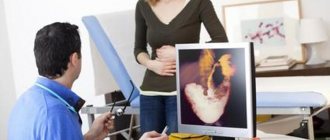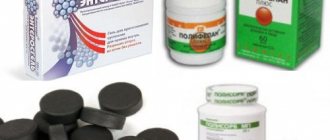Nausea is a painful sensation of discomfort in the upper abdomen, esophagus and mouth; anticipation of vomiting. When describing such symptoms, patients say “I feel sick.” Sometimes the symptoms of nausea are less pronounced, in such cases they say “nauseous.” Nausea is often accompanied by weakness, sweating, and increased salivation. A person experiencing nausea may experience a decrease in blood pressure, become pale, and feel cold in the extremities.
general characteristics
Patients characterize nausea as a painful sensation in the mouth, throat, along the esophagus, in the epigastrium, accompanied by a desire to induce vomiting or the urge to vomit.
In addition to discomfort in the gastrointestinal tract, there is often excessive secretion of saliva, an unusual taste in the mouth, coldness of the extremities, sweating, hyperhidrosis of the palms and feet. Characterized by weakness, dizziness, darkening of the eyes, unsteady gait. Compression may be felt in the epigastrium. From the outside, patients look confused, uncertain, pale, and sweaty. In some cases, a connection between nausea and food is revealed. In case of dietary errors, mild poisoning, and a number of gastroenterological diseases, the patient’s condition may improve spontaneously or after vomiting. Constant nausea lasting longer than two days is an indication for consultation with a gastroenterologist or therapist. The combination of nausea with thoracic, abdominal and headache, vomiting of blood or coffee-ground-colored masses, black tarry stools, hyperthermia over 38 ° C, convulsions, lack of urine, confusion is a sufficient reason to seek emergency medical help.
When does vomiting require immediate medical attention?
Very often, even vomiting without fever is a reason to call an ambulance as soon as possible. If the patient experiences symptoms such as vomiting blood or a previous injury to the head, spine or abdomen, or if the urge does not stop, call a doctor immediately.
JSC “Medicine” (academician Roitberg’s clinic) has its own emergency department, whose specialists are ready to come to your aid 24 hours a day, 7 days a week. You can call a car by phone.
Development mechanism
The occurrence of nausea is based on the activation of the neural arc of the gag reflex at a level insufficient for the onset of vomiting. The most common trigger for a reflex reaction is irritation of peripheral receptors located in the digestive and a number of other organs. Less commonly, the reflex is activated due to stimulation of the vomiting center, the effect of toxic substances or metabolites on the receptive zone of the bottom of the fourth ventricle of the brain. In a number of conditions (for example, pregnancy), a combination of several triggering factors is possible.
Regardless of the reasons that provoked the development of nausea, the mechanism of its formation is based on a single pathophysiological process. When the vomiting center is activated, the tone of the muscular lining of the stomach decreases, its peristalsis slows down or completely stops. A simultaneous increase in the tone of the duodenum and the proximal part of the jejunum causes duodenogastric reflux. An increase in the volume of gastric chyme leads to reflex relaxation of the cardia, contraction of the antrum, diaphragm and intercostal muscles, which is perceived as a urge to vomit.
Classification
When systematizing the forms of nausea, its duration, features of onset and mechanism of development are taken into account. Based on the duration of discomfort, episodic and permanent forms of the disorder are distinguished. Episodic nausea usually occurs suddenly and may or may not be related to food. More often it appears due to errors in nutrition, poisoning, and other acute conditions. Constant nausea of varying intensity is more typical for damage to the central nervous system and chronic diseases. Depending on the pathogenesis, the following symptom options are distinguished:
- Central (cerebral) nausea
. Based on stimulation of the vomiting center in pathology of the nervous system. It is observed in cases of inflammatory or tumor damage to the substance and membranes of the brain, traumatic brain injuries, and hypertensive crises. It may occur suddenly or bother the patient for a long time. After vomiting, the condition, as a rule, does not improve, but often worsens. - Toxic nausea
. Associated with activation of the vomiting center due to irritation by exo- and endotoxins of the chemoreceptor zone in the bottom of the fourth ventricle. It is observed in case of poisoning with drugs, toxic products and substances, toxic metabolites in liver and kidney failure, radiation sickness, ketoacidosis in patients with diabetes. The intensity of the symptom depends on the severity of intoxication. - Reflex nausea
. Caused by irritation of the receptor apparatus of the nervous chain of the gag reflex. Nerve endings that stimulate the appearance of nausea are located in the root of the tongue, the posterior wall of the pharynx, the stomach, the ileocecal zone, the intestines, the pancreas, the hepatobiliary system, the peritoneum, the inner ear and other organs. It is most often associated with food intake and manifests itself in the structure of gastrointestinal diseases. - Vestibular (motor) nausea
. It is provoked by a change in body position, direction or speed of movement with irritation of the vestibular apparatus and stimulation of the vomiting center. In a healthy person, it occurs in the form of motion sickness when driving a car or rotating the body. Characteristic of brain pathology with damage to the inner ear, cerebellopontine angle and vestibular stem nuclei. - Psychogenic nausea
. Observed during the implementation of a firmly established conditioned reflex. Triggers of nausea are olfactory and visual sensations that cause disgust or unpleasant emotions. It often manifests itself in neurotic and neurosis-like conditions, psychogenic disorders, overwork, and conflicts. It can serve as a somatoform manifestation of depression and psychotic disorders. - Exchange nausea
. Develops due to disturbances in the physiological transformation of nutrients against the background of vitamin, mineral, and endocrine deficiency. It is probably realized through the influence of metabolites on the receptor zone of the medulla oblongata and activation of nerve endings against the background of secondary damage to the gastrointestinal tract. Identified in patients with hypothyroidism, hyperfunction of the parathyroid glands, premenstrual syndrome, etc.
Useful tips
If you are worried about nausea and vomiting, weakness, here are some useful recommendations that will help alleviate the condition:
- Abundant air flow - you can open a window or sit in front of a fan.
- Drinking fluids. Drink more water, it will also help prevent dehydration and speed up your metabolism.
- Compress. The feeling of nausea will go away if you apply a cold compress to the forehead and neck area.
- Do not lie down, the bitterness in your mouth and nausea will intensify - gastric juice may rise up the esophagus. This is why gastroenterologists do not advise “resting” after eating.
It is recommended to drink at least 1 glass of warm water every morning on an empty stomach. The liquid will “wake up” the gastrointestinal tract and normalize metabolism. Also follows:
- minimize the amount of “heavy” food in the diet;
- exclude carbonated drinks;
- take care of the cleanliness of products that do not require heat treatment (berries, vegetables, fruits).
As a sorbent for quick relief of abdominal pain, if nausea and vomiting occur due to poisoning and allergies, always have supplements in the form of Sorbex enterosorbent in your medicine cabinet.
SORBEX® Duo
SORBEX® Classic
SORBEX® Ultra
Medicines and dietary supplements of the Sorbex series (Sorbex, Sorbex Ultra, Sorbex DUO) are based on improved activated carbon. Thanks to modern production technologies, the sorption capacity of Sorbex® has been significantly increased, which ensures its high sorption ability to absorb toxins, bacteria and other harmful substances.
Sorbex capsules contain activated carbon in the form of granules, which ensures adsorption activity throughout the entire residence time of the sorbent in the gastrointestinal tract. The effectiveness of granular carbon almost does not decrease within 36-48 hours, which allows you to increase the intervals between doses of this drug and reduce the dose. For adults with chronic diseases caused by endogenous intoxications, it is recommended to take 2–6 capsules 3 times a day for 10–15 days. For children over 7 years old, take 1-3 capsules 3-4 times a day. The drug is administered orally with water at intervals of 1.5–2 hours before or after meals or medications.
SORBEX ULTRA is a dietary supplement in the form of capsules based on highly dispersed activated carbon with extremely high adsorption activity, therefore it is especially effective for acute poisoning. Adults are recommended to take 1 capsule 2-3 times a day.
SORBEX DUO is a dietary supplement for the comprehensive cleansing of toxins from the body, combining the unique properties of a hydrocarbon sorbent in the form of granules and milk thistle extract. Thanks to this composition, SORBEX DUO helps reduce the manifestations of intoxication, protects and restores liver function. Adults take 2-3 capsules 2-3 times a day. Children aged 7 years and older – 1 capsule 2-3 times a day before or 1-1.5 hours after meals. Duration of use from 3 to 15 days
It should be borne in mind that sometimes nausea may be the only early sign of serious illness, so this symptom should not be ignored and you should consult a doctor.
Attention! Self-medication can harm your health!
Causes of nausea
Causes of nausea after eating
In some patients, nausea associated in time with eating food is of physiological origin and is caused by overeating, errors in diet, and changes during pregnancy. Pathological causes of nausea after eating are:
- Stomach diseases
: acute gastritis, atony, neoplasms. - Food allergies
. - Intoxication of the body
: food poisoning, poisoning with plant poisons, overdose of medications. - Diseases of the pancreato-duodenal zone
: duodeno-gastric reflux, duodenostasis, chronic pancreatitis (including alcoholic). - Pathology of the hepatobiliary system
: chronic cholecystitis and cholangitis, biliary dyskinesia, liver echinococcosis. - Infectious processes
: rotavirus and norovirus infections, escherichiosis, salmonellosis. - Complications after surgical interventions
: dumping syndrome, postcholecystectomy syndrome.
Causes of nausea on an empty stomach
A healthy person may experience nausea on an empty stomach when taking certain medications (vitamins, iron supplements) before meals. In most cases, the appearance of a symptom indicates damage to the gastrointestinal tract, less often - other pathological conditions. The causes of nausea on an empty stomach are:
- Gastrointestinal
diseases : esophageal erosions, gastritis and peptic ulcers, irritable stomach syndrome. - Parasitic infestations
: giardiasis, toxoplasmosis, ascariasis. - Endogenous poisoning
: uremia, chronic renal failure, cancer intoxication. - Migraine
. - Early toxicosis during pregnancy
. - Emergency conditions
: hypertensive crisis, “acute abdomen” syndrome (appendicitis, peritonitis).
Causes of nausea during pregnancy
Nausea is one of the most common symptoms that bother pregnant women. It is usually explained by a complex restructuring of the body to bear a child, but it can also have pathological causes. Nausea during pregnancy is caused by:
- Physiological prerequisites
: overeating, uterine growth, defecation delay. - Early toxicosis.
- Pregnancy pathologies
: gestosis and eclampsia, pregnancy hyperthyroidism, polyhydramnios, cholestasis. - Concomitant gastrointestinal diseases
: GERD, chronic gastritis and pancreatitis, dysbacteriosis. - Ovarian hyperstimulation syndrome
.
Symptoms
This condition is associated with the following manifestations:
- What is a “lump in the throat” and how to get rid of it
- feeling of a lump in the throat (it cannot be felt, but the patient feels it);
- difficulty breathing (the patient feels a lack of oxygen);
- difficulties with swallowing (a person tries to swallow a lump stuck in the throat, but nothing works; in some cases, difficulties with swallowing food are real);
- in certain situations, pain and burning sensations appear inside the throat;
- general lethargy and malaise are rarely observed.
With the problem of a lump in the throat, it is best to first contact a therapist. He determines the nature of the pathology and refers to a specialized doctor.
Diagnostics
Patients with complaints of nausea are initially referred to a gastroenterologist. The doctor conducts a comprehensive examination of the digestive system to identify structural and functional disorders, which are most often accompanied by nausea. To determine the cause of nausea, laboratory and instrumental studies are used, the most informative of which are considered:
- Ultrasonic method
. Ultrasound of the abdominal organs is a non-invasive and safe examination that can be prescribed to all patients, including pregnant women. Using sonography, the doctor detects organic causes in the gastrointestinal tract and biliary system: thickening or deformation of organ walls, space-occupying formations. - X-ray examination
. Nausea is a common symptom of diseases of the esophagus and duodeno-gastric zone, for the detection of which radiography with barium contrast is used. To assess the patency of the digestive tract and the rate of passage of chyme, a series of delayed x-rays are performed. - Endoscopic examination
. Using endoscopy, the condition of the upper gastrointestinal tract is visually assessed: the mucous membrane is examined, signs of inflammation and destruction are identified, and a biopsy of altered tissue areas is performed. If reflux is suspected, the method is supplemented by performing 24-hour pH measurements inside the stomach and lower part of the esophagus. - Examination of feces
. A coprogram is carried out to detect characteristic signs of gastrointestinal pathologies, which are manifested by nausea. If there are symptoms of an intestinal infection as the cause of vomiting, bacteriological culture of stool is recommended to detect microorganisms. Additionally, the level of fecal elastase is determined. - Lab tests
. To clarify the diagnosis, a biochemical blood test with liver tests and an assessment of the levels of acute phase indicators are indicated. Using serological reactions, pathogens of intestinal infections are identified and helicobacteriosis is detected. The method is supplemented with specific breathing tests.
If there are difficulties in diagnosis, CT or MRI of the abdominal cavity, duodenal intubation with bacteriological culture of bile are performed. Sometimes allergy tests are performed with the most common allergens. Women who complain of nausea should be referred to a gynecologist for consultation. After excluding gastroenterological pathology, a comprehensive neurological examination and consultation with other specialists are indicated.
Various medications are used to relieve nausea
Answers to the most common questions
- I am vomiting and have a fever, what should I do? You should not self-medicate; in this case, it is recommended to see a doctor as soon as possible.
- What does vomiting in the morning mean? It might be worth checking to see if you are pregnant. In all other cases, you should seek medical advice from a doctor.
- White vomit with mucus - what to do? Most likely, the person has recently consumed too much white bread, milk or rice. If there are no other signs of illness, then there is no need to panic.
Treatment
Help before diagnosis
To reduce the intensity of nausea, it is recommended to drink ginger or mint tea and slowly eat a slice of lemon. It is better to eat food in small portions, avoid smoked and spicy foods, carbonated drinks and fast food. After eating, it is undesirable to take a horizontal position. People prone to allergies should limit their consumption of strawberries, peanuts, and citrus fruits as much as possible. Severe prolonged nausea, which makes it difficult to eat and is accompanied by vomiting, is grounds for contacting a gastroenterologist.
Conservative therapy
The treatment regimen is selected individually, after identifying the cause of nausea. In addition to medications, diet therapy and psychotherapy methods are used, which are especially effective for functional digestive disorders in pregnant women. Etiotropic and pathogenetic therapy are aimed at eliminating the cause of the underlying disease and individual parts of the mechanism of its development; medications are also prescribed to relieve unpleasant symptoms. The most commonly used groups of pharmaceuticals are:
- Sedative herbal medicines
. For moderate nausea, herbal medicines (valerian, motherwort) help, which normalize the autonomic nervous regulation of the digestive tract. Sometimes combined medications and bromides are used. - Antihistamines
. These remedies are good for relieving nausea, the causes of which are associated with an allergic reaction to food. For systemic allergies, short courses of glucocorticosteroid hormones are additionally prescribed. - Prokinetics
. Medicines stimulate peristalsis of the digestive tract, normalize the tone of the esophageal and gastric sphincters. To eliminate nausea, prokinetics are often combined with enterosorbents. - Antisecretory agents
. Proton pump inhibitors and H2 receptor blockers are indicated for nausea caused by increased stomach acid. A new class of drugs - prostaglandins - is highly effective. - Serotonin receptor antagonists
. Medicines have a strong effect because they directly affect receptors in the brain. Recommended for nausea that is not relieved by other means. - Antibacterial drugs
. Medicines in this group are used in cases where nausea is caused by intestinal infections. For parasitic infestations, anthelmintic and antiprotozoal drugs are indicated.
First aid
In the absence of chronic and current diseases, the doctor will prescribe treatment aimed at restoring the body. First of all, the patient will be advised to:
- Establish an enhanced drinking regime.
- Take anti-inflammatory and painkillers.
- In some cases, when it comes to severe forms of roto- or enterovirus, antibiotics are prescribed.
To remove toxins from the body, therapy may be accompanied by simultaneous intake of sorbents. The Sorbex series are safe enterosorbents that do not treat the disease, but can alleviate its symptoms and course. Their composition is based on granular activated carbon, which absorbs harmful substances and removes them from the body naturally. In the available line of products you can choose drugs for children and adults.








